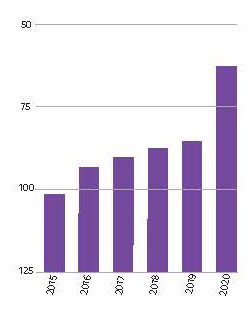Why did Cornell experience a major rankings jump?

The U.S. News rankings moved Cornell up to No. 68 for national liberal arts colleges—a significant jump. Why? While we can’t identify the exact formula for rankings, we’ve seen a direct correlation between the implementation of our strategic plan initiatives and how our rank has changed.
 Cornell’s rise in the U.S. News and World Report has paralleled the implementation of our strategic objectives for the past five years—from a ranking of 105 in 2015 to 68 for 2020.
Cornell’s rise in the U.S. News and World Report has paralleled the implementation of our strategic objectives for the past five years—from a ranking of 105 in 2015 to 68 for 2020.
In addition, the magazine’s first-ever social mobility ranking placed Cornell at No. 1 among liberal arts colleges. That’s first in the nation among our peers.
Strategically, Cornell puts a focus on facilities, knowing that students need updated spaces to study, complete research, build community, compete in athletics, and call home at the end of the day.
2015: Renovated four residence halls (see photo above)
2015: Renovated baseball field in partnership with the Mount Vernon schools
2015: Installed synthetic grass and lights for football and lacrosse field
2018: Opened Russell Science Center
2018: Renovated Van Metre Field at Ash Park
2019: Completed new soccer field
2019: Renovated West Science Hall
We set a goal to reimagine the liberal arts and challenged ourselves to consider how we serve our students with the entire curriculum, best use our One Course At A Time schedule, identify hands-on activities in every program, and provide tools for life after Cornell.
2015: Opened Cornell Summer Research Institute
2016: Opened the Berry Career Institute (merging several career services)
2017: Opened One Course Summer Institute for high school students
2019: Completed framework for our core curriculum, Ingenuity, that focuses on hands-on learning and skills building for a lifetime across many careers
2019: Launched a low-residency M.F.A. in creative writing
We’ve taken a closer look at our offerings, compared to what skills are currently in demand in the marketplace, and have launched programs that open students up to new opportunities. These programs and new minors further increase student flexibility to design their own course of study.
- Applied mathematics (minor)
- Applied statistics (minor)
- Bachelor of fine arts in musical theatre (major)
- Behavioral neuroscience (major)
- Business (major and minor)
- Dance (minor)
- Bachelor of science in engineering (major)
- Ethnic studies (minor)
- History (minor)
- Musical theatre (minor)



